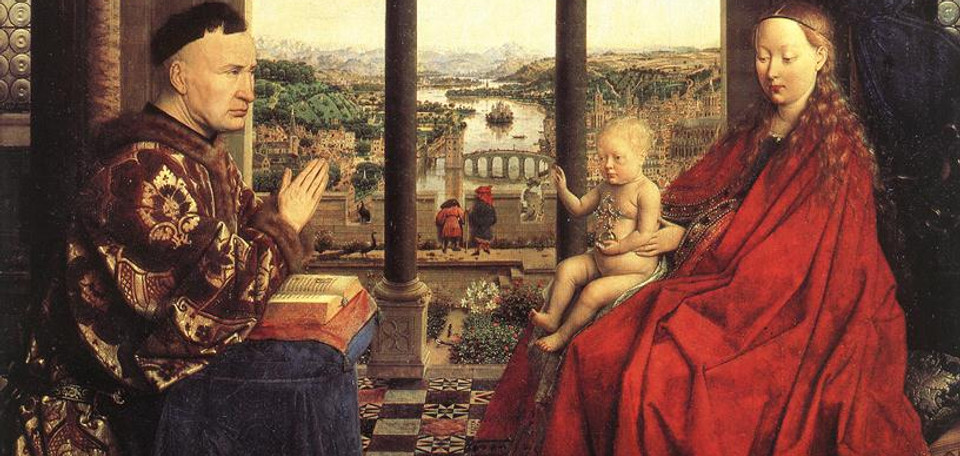Gothic Art
Gothic architecture
Gothic architecture is an architectural style that was prevalent in Europe from the late 12th to the 16th century, during the High and Late Middle Ages, surviving into the 17th and 18th centuries in some areas. It evolved from Romanesque architecture and was succeeded by Renaissance architecture. It originated in the Île-de-France and Picardy regions of northern France.
The defining design element of Gothic architecture is the pointed arch. The use of the pointed arch in turn led to the development of the pointed rib vault and flying buttresses, combined with elaborate tracery and stained glass windows.
At the Abbey of Saint-Denis, near Paris, the choir was reconstructed between 1140 and 1144, drawing together for the first time the developing Gothic architectural features. In doing so, a new architectural style emerged that emphasized verticality and the effect created by the transmission of light through stained glass windows.

The West Front of Wells Cathedral.

Sainte Chapelle Interior Stained Glass

Rouen

West portal at Reims Cathedral, Annunciation group.
Gothic Art
Gothic art was a style of medieval art that developed in Northern France out of Romanesque art in the 12th century AD, led by the concurrent development of Gothic architecture. It spread to all of Western Europe, and much of Northern, Southern and Central Europe, never quite effacing more classical styles in Italy. In the late 14th century, the sophisticated court style of International Gothic developed, which continued to evolve until the late 15th century. In many areas, especially Germany, Late Gothic art continued well into the 16th century, before being subsumed into Renaissance art. Primary media in the Gothic period included sculpture, panel painting, stained glass, fresco and illuminated manuscripts. The easily recognizable shifts in architecture from Romanesque to Gothic, and Gothic to Renaissance styles, are typically used to define the periods in art in all media, although in many ways figurative art developed at a different pace.
The earliest Gothic art was monumental sculpture, on the walls of Cathedrals and abbeys. Christian art was often typological in nature , showing the stories of the New Testament and the Old Testament side by side. Saints' lives were often depicted. Images of the Virgin Mary changed from the Byzantine iconic form to a more human and affectionate mother, cuddling her infant, swaying from her hip, and showing the refined manners of a well-born aristocratic courtly lady.
Secular art came into its own during this period with the rise of cities, foundation of universities, increase in trade, the establishment of a money-based economy and the creation of a bourgeois class who could afford to patronize the arts and commission works, resulting in a proliferation of paintings and illuminated manuscripts. Increased literacy and a growing body of secular vernacular literature encouraged the representation of secular themes in art. With the growth of cities, trade guilds were formed and artists were often required to be members of a painters' guild. As a result, because of better record keeping, more artists are known to us by name in this period than any previous; some artists were even so bold as to sign their names.
GIOTTO di Bondone
c.1267 - 1337
Giotto di Bondone (c. 1267 – January 8, 1337), known mononymously as Giotto and Latinised as Giottus, was an Italian painter and architect from Florence during the Late Middle Ages. He worked during the Gothic and Proto-Renaissance period. Giotto's contemporary, the banker and chronicler Giovanni Villani, wrote that Giotto was "the most sovereign master of painting in his time, who drew all his figures and their postures according to nature" and of his publicly recognized "talent and excellence". Giorgio Vasari described Giotto as making a decisive break from the prevalent Byzantine style and as initiating "the great art of painting as we know it today, introducing the technique of drawing accurately from life, which had been neglected for more than two hundred years".
Giotto's masterwork is the decoration of the Scrovegni Chapel, in Padua, also known as the Arena Chapel, which was completed around 1305. The fresco cycle depicts the Life of the Virgin and the Life of Christ. It is regarded as one of the supreme masterpieces of the Early Renaissance.
The fact that Giotto painted the Arena Chapel and that he was chosen by the Commune of Florence in 1334 to design the new campanile (bell tower) of the Florence Cathedral are among the few certainties about his life. Almost every other aspect of it is subject to controversy: his birth date, his birthplace, his appearance, his apprenticeship, the order in which he created his works, whether he painted the famous frescoes in the Upper Basilica of Saint Francis in Assisi, and his burial place.

Posthumous portrait of Giotto, made between 1490 and 1550

Legend of St. Francis

The Crucifixion of Rimini
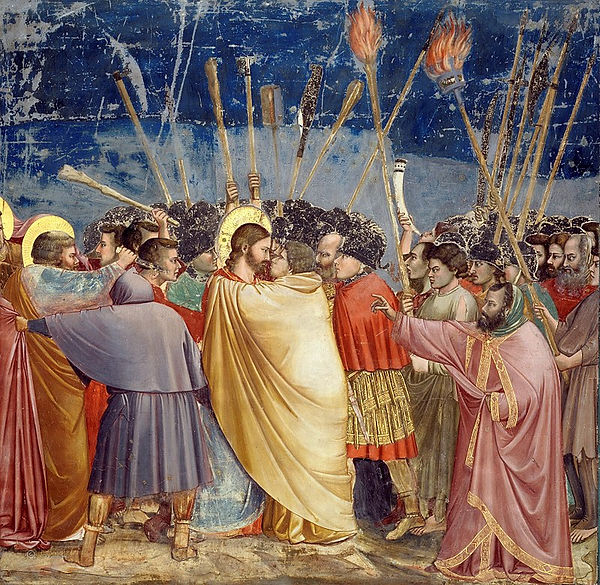
Kiss of Judas,
Scrovegni Chapel

Lamentation (The Mourning of Christ),
Scrovegni Chapel

Ognissanti Madonna (c. 1310).

The Nativity in the Lower Church, Assisi

Peruzzi Altarpiece,
c.1322

Madonna and Child
1297

Entombment
1320-25

Baroncelli Polyptych (detail)
c. 1334
Robert Campin
c.1375-1444
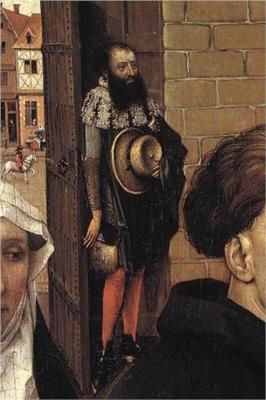
Robert Campin (c. 1375 – 26 April 1444), now usually identified with the Master of Flémalle (earlier the Master of the Merode Triptych, before the discovery of three other similar panels), was a master painter who, along with Jan van Eyck, initiated the development of Early Netherlandish painting, a key development in the early Northern Renaissance.
While the existence of a highly successful painter called Robert Campin is relatively well documented for the period, no works can be certainly identified as by him through a signature or contemporary documentation. A group of paintings, none dated, have been long attributed to him, and a further group were once attributed to an unknown "Master of Flémalle". It is now usually thought that both groupings are by Campin, but this has been a matter of some controversy for decades.
A corpus of work is attached to the unidentified "Master of Flémalle," so named in the 19th century after three religious panels said to have come from a monastery in Flémalle. They are each assumed to be wings of triptychs or polyptychs, and are the Virgin and Child with a Firescreen now in London, a panel fragment with the Thief on the Cross in Frankfurt, and the Brussels version of the Mérode Altarpiece.
Campin was active by 1406 as a master painter in Tournai, in today's Belgium, and became that city's leading painter for 30 years. He had attained citizenship by 1410. His fame had spread enough by 1419 that he led a large and profitable workshop. He had an extra-marital affair with a woman named Leurence Pol, led to his imprisonment. Yet he maintained his standing and workshop until his death in 1444.
The early Campin panels shows the influence of the International Gothic artists the Limbourg brothers (1385–1416) and Melchior Broederlam (c. 1350 – c.1409), but display a more realistic observation than any earlier artists, which he achieved through innovations in the use of oil paints. He was successful in his lifetime, and the recipient of a number of civic commissions. Campin taught both Rogier van der Weyden (named in these early records as Rogelet de la Pasture, a French version of his name) and Jacques Daret. He was a contemporary of Jan van Eyck, and they met in 1427. Campin's best known work is the Mérode Altarpiece of c 1425–28.

Portrait of a Man,
c. 1435

Portrait of a Woman,
c. 1435

The Seilern Triptych,
c. 1425
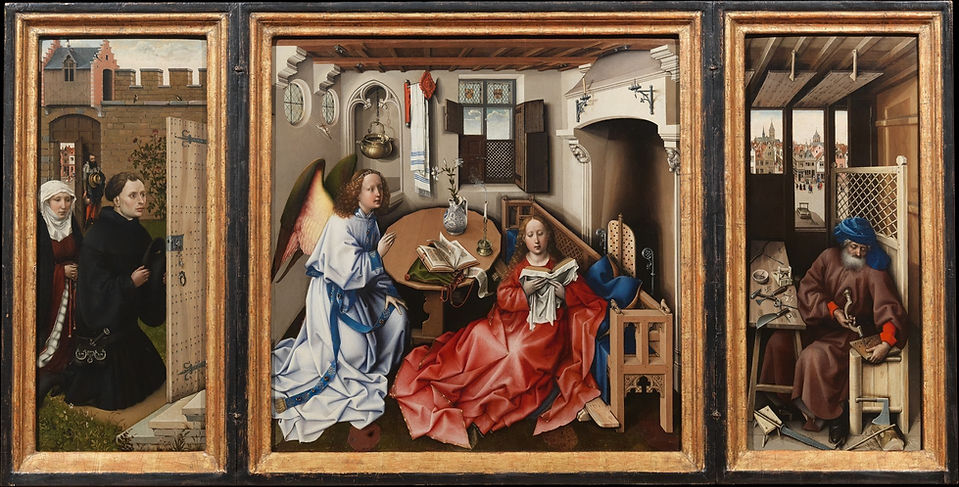
The Mérode Altarpiece
c. 1425

Descent from the Cross

The Werl Altarpiece,
1438

Mass of Saint Gregory
c.1415

Madonna and Child
1430

Virgin and Child Before a Firescreen
c.1440

Samian Sibyl
LIMBOURG brothers
(Herman, Jean, Paul)
The Limbourg brothers (Dutch: Gebroeders van Limburg or Gebroeders Van Lymborch; fl. 1385 – 1416) were Dutch miniature painters (Herman, Paul, and Jean) from the city of Nijmegen. They were active in the early 15th century in France and Burgundy, working in the International Gothic style.
They painted the miniatures and decorated page margins for the best-known late medieval illuminated manuscript, the Très Riches Heures du Duc de Berry, the Belles Heures of Jean de France, Duc de Berry, in both of which their work survives largely complete although, like many grand manuscript projects, the Très Riches Heures was not finished.

Les très riches heures du Duc de Berry: Janvier (January)
1412-16

Les très riches heures du Duc de Berry: January (detail)
1412-16

Les très riches heures du Duc de Berry: Fevrier (February)
1412-16

Les très riches heures du Duc de Berry: Fevrier (February), detail
1412-16

Les très riches heures du Duc de Berry: Mars (March)
1412-16

Les très riches heures du Duc de Berry: Avril (April)
1412-16
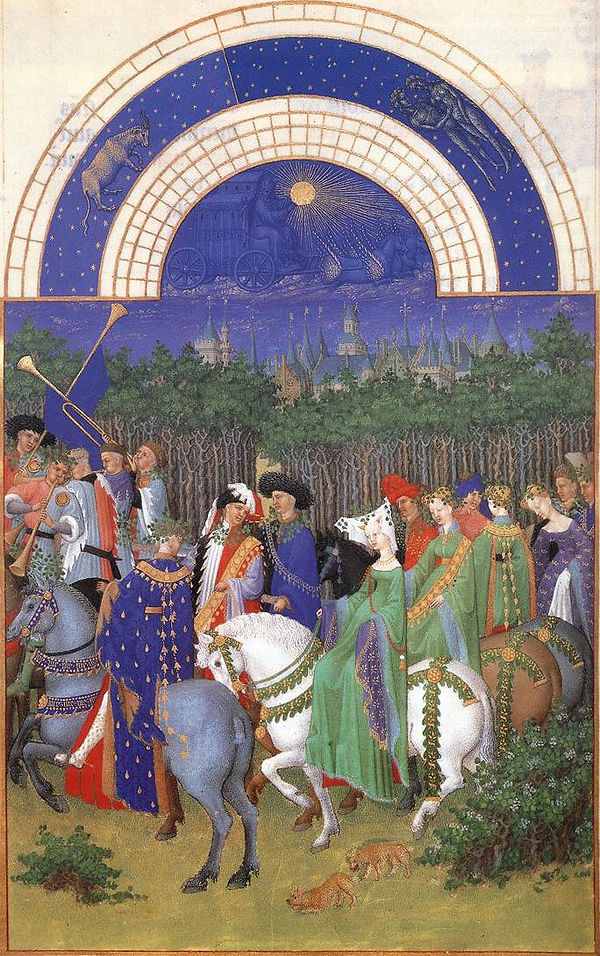
Les très riches heures du Duc de Berry: Mai (May)
1412-16

Les très riches heures du Duc de Berry: Mai (detail)
1412-16

Les très riches heures du Duc de Berry: Juin (June)
1412-16

Les très riches heures du Duc de Berry: Juillet (July)
1412-16

Les très riches heures du Duc de Berry: Aout (August)
1412-16

Les très riches heures du Duc de Berry: Septembre (September)
1412-16

Les très riches heures du Duc de Berry: Octobre (October)
1412-16

Les très riches heures du Duc de Berry: Novembre (November)
1412-16
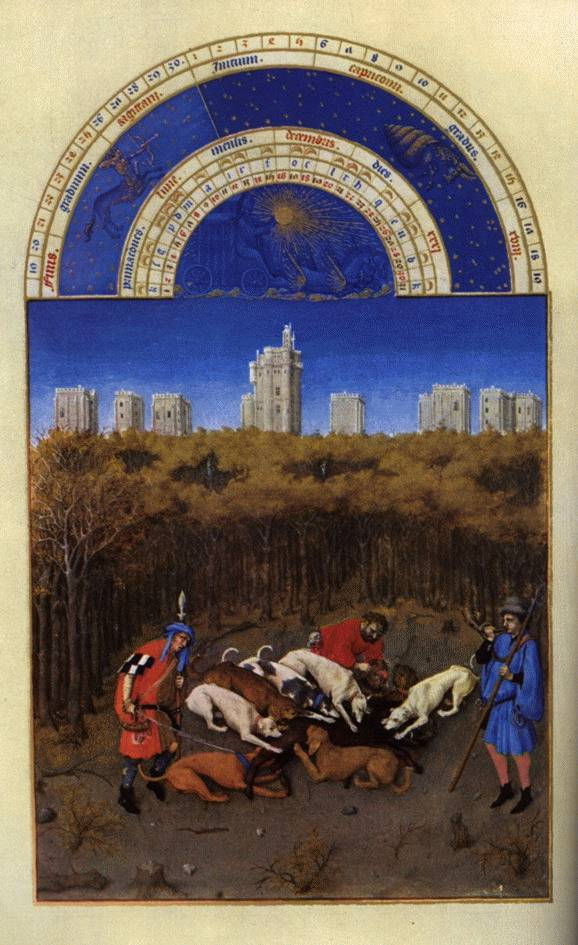
Les très riches heures du Duc de Berry: Décembre (December)
1412-16

Les très riches heures du Duc de Berry: Fevrier (February), detail
1412-16

Les très riches heures du Duc de Berry
c. 1416

Les très riches heures du Duc de Berry
c. 1416

Les très riches heures du Duc de Berry
c. 1416

Les très riches heures du Duc de Berry
c. 1416

Les très riches heures du Duc de Berry
c. 1416
Jan van Eyck
c.1390-1441
Jan van Eyck (c. before 1390 – 9 July 1441) was a Flemish painter active in Bruges who was one of the early innovators of what became known as Early Netherlandish painting, and one of the most significant representatives of Early Northern Renaissance art. According to Vasari and other art historians including Ernst Gombrich, he invented oil painting, though most now regard that claim as an oversimplification.
The surviving records indicate that he was born around 1380 or 1390, in Maaseik (then Maaseyck, hence his name), Limburg, which is located in present-day Belgium. He took employment in The Hague around 1422, when he was already a master painter with workshop assistants, and was employed as painter and valet de chambre to John III the Pitiless, ruler of the counties of Holland and Hainaut. After John's death in 1425, he was later appointed as court painter to Philip the Good, Duke of Burgundy, and worked in Lille before moving to Bruges in 1429, where he lived until his death. He was highly regarded by Philip, and undertook a number of diplomatic visits abroad, including to Lisbon in 1428 to explore the possibility of a marriage contract between the duke and Isabella of Portugal.[2]
About 20 surviving paintings are confidently attributed to him, as well as the Ghent Altarpiece and the illuminated miniatures of the Turin-Milan Hours, all dated between 1432 and 1439. Ten are dated and signed with a variation of his motto ALS ICH KAN (As I (Eyck) can), a pun on his name, which he typically painted in Greek characters.
Van Eyck painted both secular and religious subject matter, including altarpieces, single-panel religious figures and commissioned portraits. His work includes single panels, diptychs, triptychs, and polyptych panels. He was well paid by Philip, who sought that the painter was secure financially and had artistic freedom so that he could paint "whenever he pleased". Van Eyck's work comes from the International Gothic style, but he soon eclipsed it, in part through a greater emphasis on naturalism and realism. He achieved a new level of virtuosity through his developments in the use of oil paint.[5] He was highly influential, and his techniques and style were adopted and refined by the Early Netherlandish painters.

Portrait of a Man by Jan van Eyck
1433

Diptych
1420-25

Diptych (detail)
1420-25

The Virgin of Chancellor Rolin
1435

Small Triptych
c. 1437

Small Triptych (central panel)
c. 1437

The Ghent Altarpiece
1432

The Ghent Altarpiece: Adam
1432

The Ghent Altarpiece: Eve
1432

The Ghent Altarpiece: Virgin Mary (detail)
1432

The Ghent Altarpiece: Singing Angels
1432

The Ghent Altarpiece: Angels Playing Music
1432

The Ghent Altarpiece: Adoration of the Lamb
1432

Portrait of Giovanni Arnolfini and his Wife
1434

The Madonna with Canon van der Paele
1436
Fra Angelico
c.1395-1455
Fra Angelico, (born Guido di Pietro; c. 1395 – 18 February 1455) was a Dominican friar and Italian painter of the Early Renaissance, described by Giorgio Vasari in his Lives of the Artists as having "a rare and perfect talent". He earned his reputation primarily for the series of frescoes he made for his own friary, San Marco, in Florence, then worked in Rome and other cities. All his known work is of religious subjects.
He was known to contemporaries as Fra Giovanni da Fiesole (Brother John of Fiesole) and Fra Giovanni Angelico (Angelic Brother John). In modern Italian he is called Beato Angelico (Blessed Angelic One); the common English name Fra Angelico means the "Angelic friar".
In 1982, Pope John Paul II proclaimed him "blessed" in recognition of the holiness of his life, thereby making the title of "Blessed" official. Fiesole is sometimes misinterpreted as being part of his formal name, but it was merely the town where he had taken his vows as a Dominican friar, and would have been used by contemporaries to distinguish him from others with the same forename, Giovanni. He is listed in the Roman Martyrology as Beatus Ioannes Faesulanus, cognomento Angelicus—"Blessed John of Fiesole, surnamed 'the Angelic'".
Vasari wrote of Fra Angelico that "it is impossible to bestow too much praise on this holy father, who was so humble and modest in all that he did and said and whose pictures were painted with such facility and piety."

Posthumous portrait of Fra Angelico by Luca Signorelli, detail of Deeds of the Antichrist fresco (c.1501) in Orvieto Cathedral.

San Domenico Altarpiece
1423-24

Prado Altarpiece
(1430-32)

Last Judgment
c. 1431

Last Judgment (detail)
c. 1431

The Cortona Altarpiece (The Annunciation)
1433-34

The Cortona Altarpiece (The Annunciation)
1433-34

Cortona Polyptych
c. 1437

Perugia Altarpiece
1447-48

Deposition from the Cross (Pala di Santa Trinità)
1437-40

Deposition from the Cross (detail)
1437-40

The Adoration of the Magi
c. 1445

Adoration of the Magi (detail)
c. 1445
Paolo Uccello
1397-1476
Paolo Uccello (1397 – 10 December 1475), born Paolo di Dono, was an Italian painter and mathematician who was notable for his pioneering work on visual perspective in art. In his book Lives of the Most Excellent Painters, Sculptors, and Architects, Giorgio Vasari wrote that Uccello was obsessed by his interest in perspective and would stay up all night in his study trying to grasp the exact vanishing point. Uccello used perspective to create a feeling of depth in his paintings. His best known works are the three paintings representing the battle of San Romano, which were wrongly entitled the Battle of Sant'Egidio of 1416 for a long period of time.
Paolo worked in the Late Gothic tradition, emphasizing colour and pageantry rather than the classical realism that other artists were pioneering. His style is best described as idiosyncratic, and he left no school of followers. He has had some influence on twentieth-century art and literary criticism (e.g., in the Vies imaginaires by Marcel Schwob, Uccello le poil by Antonin Artaud and O Mundo Como Ideia by Bruno Tolentino).
The sources for Paolo Uccello's life are few: Giorgio Vasari's biography, written 75 years after Paolo's death, and a few contemporary official documents. Uccello probably was born in 1397 in Pratovecchio (near Arezzo), the hometown of his father, Dono di Paolo, a barber-surgeon. His mother, Antonia, was a high-born Florentine. His nickname Uccello ("little bird") came from his fondness for painting birds.
From 1412 until 1416 he was apprenticed to the famous sculptor Lorenzo Ghiberti. Ghiberti was the creator of the doors of the Florence Baptistery and his workshop was the premier centre for Florentine art at the time. Ghiberti's late-Gothic, narrative style and sculptural composition greatly influenced Paolo. It was also around this time that Paolo began his lifelong friendship with Donatello. In 1414, Uccello was admitted to the painters' guild, Compagnia di San Luca, and just one year later, in 1415, he joined the official painter's guild of Florence Arte dei Medici e degli Speziali. Although the young Uccello had probably left Ghiberti's workshop by the mid 1420s, he stayed on good terms with his master and may have been privy to the designs for Ghiberti's second set of Baptistery doors, The Gates of Paradise. These featured a battle scene "that might well have impressed itself in the mind of the young Uccello," and thus influenced The Battle of San Romano.

Paolo Uccello

Miracle of the Desecrated Host
1465-69

Miracle of the Desecrated Host Scene 1
1465-69
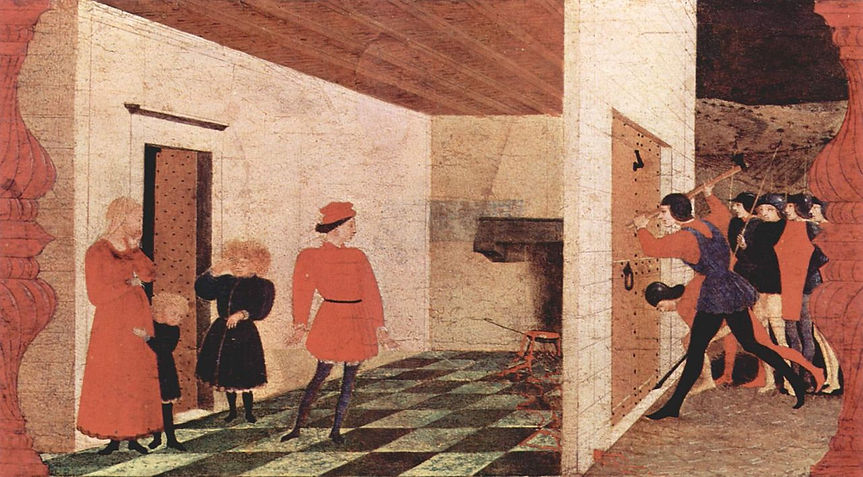
Miracle of the Desecrated Host Scene 2
1465-69

Miracle of the Desecrated Host Scene 3
1465-69

Miracle of the Desecrated Host Scene 4
1465-69

Miracle of the Desecrated Host Scene 5
1465-69

Miracle of the Desecrated Host Scene 6
1465-69

Saint George and the Dragon (c. 1470)

Niccolò Mauruzi da Tolentino at the Battle of San Romano
(probably c. 1438–1440)

Niccolò Mauruzi da Tolentino unseats Bernardino della Carda at the Battle of San Romano
(dating uncertain, c. 1435–1455)

The Counterattack of Michelotto da Cotignola at the Battle of San Romano
(c. 1455)

The Hunt
(1397-1475 CE)

Disputation of St Stephen
c.1435

Stoning of St.Stephen
c.1435

Portrait Of A Lady
1450

Episodes of the hermit life
1460

A Young Lady of Fashion
1464

Portrait of a Young Man
1440
Rogier van der Weyden
1400-1464
Rogier van der Weyden (1399 or 1400 – 18 June 1464) was an early Netherlandish painter whose surviving works consist mainly of religious triptychs, altarpieces, and commissioned single and diptych portraits. He was highly successful in his lifetime; his paintings were exported to Italy and Spain, and he received commissions from, amongst others, Philip the Good, Netherlandish nobility, and foreign princes. By the latter half of the 15th century, he had eclipsed Jan van Eyck in popularity. However his fame lasted only until the 17th century, and largely due to changing taste, he was almost totally forgotten by the mid-18th century. His reputation was slowly rebuilt during the 200 years that followed; today he is known, with Robert Campin and van Eyck, as the third (by birth date) of the three great Early Flemish artists (Vlaamse Primitieven or "Flemish Primitives"), and widely as the most influential Northern painter of the 15th century.
Very few details of van der Weyden's life are known. The few facts we know come from fragmentary civic records. Yet the attribution of paintings now associated to him is widely accepted, partly on the basis of circumstantial evidence, but primarily on the stylistic evidence of a number of paintings by an innovative master.
Van der Weyden worked from life models, and details were closely observed. Yet he often idealised certain elements of his models' facial features, who were typically statuesque, especially in his triptychs. All of his forms are rendered with rich, warm colourisation and a sympathetic expression, while he is known for his expressive pathos and naturalism. His portraits tend to be half length and half profile, and he is as sympathetic here as in his religious triptychs. Van der Weyden used an unusually broad range of colours and varied tones; in his finest work the same tone is not repeated in any other area of the canvas, so even the whites are varied.
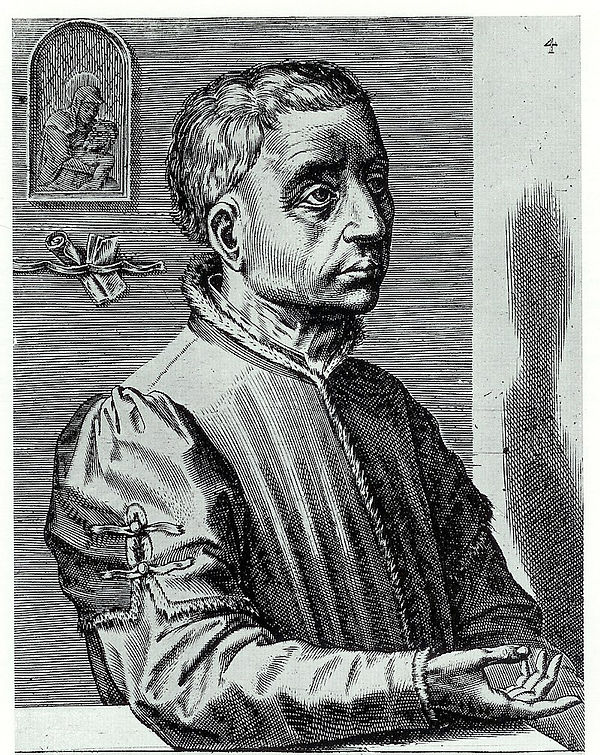
Imaginative portrait by Cornelis Cort,
1572

Deposition in the Prado, Madrid

St Luke Drawing the Portrait of the Madonna
c. 1450

Annunciation Triptych
c. 1440

Mary Altarpiece (Miraflores Altarpiece)
c. 1440

Seven Sacraments Altarpiece
1445-50

Crucifixion Triptych
c. 1445

Bladelin Triptych
1445-50

The Last Judgment Polyptych
1446-52

The Last Judgment Polyptych (detail)
1446-52

Braque Family Triptych
c. 1450

Braque Family Triptych (central panel)
c. 1450

St Columba Altarpiece
c. 1455

St Columba Altarpiece (central panel)
c. 1455

St John Altarpiece
1455-60

St John Altarpiece (detail)
1455-60
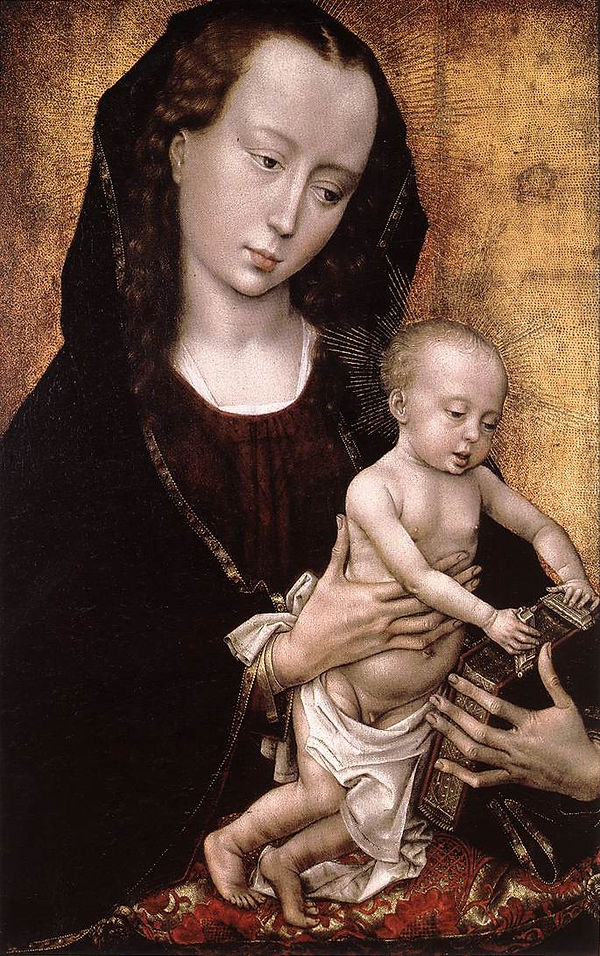
Portrait Diptych of Philippe de Croy
c. 1460

Portrait of a Woman with a Winged Bonnet,
c. 1440.

Portrait of a Lady,
c. 1460.

Portrait of Isabella of Portugal,
c. 1450

Portrait of Francesco d'Este,
c. 1460

The Magdalene Reading
c. 1445
